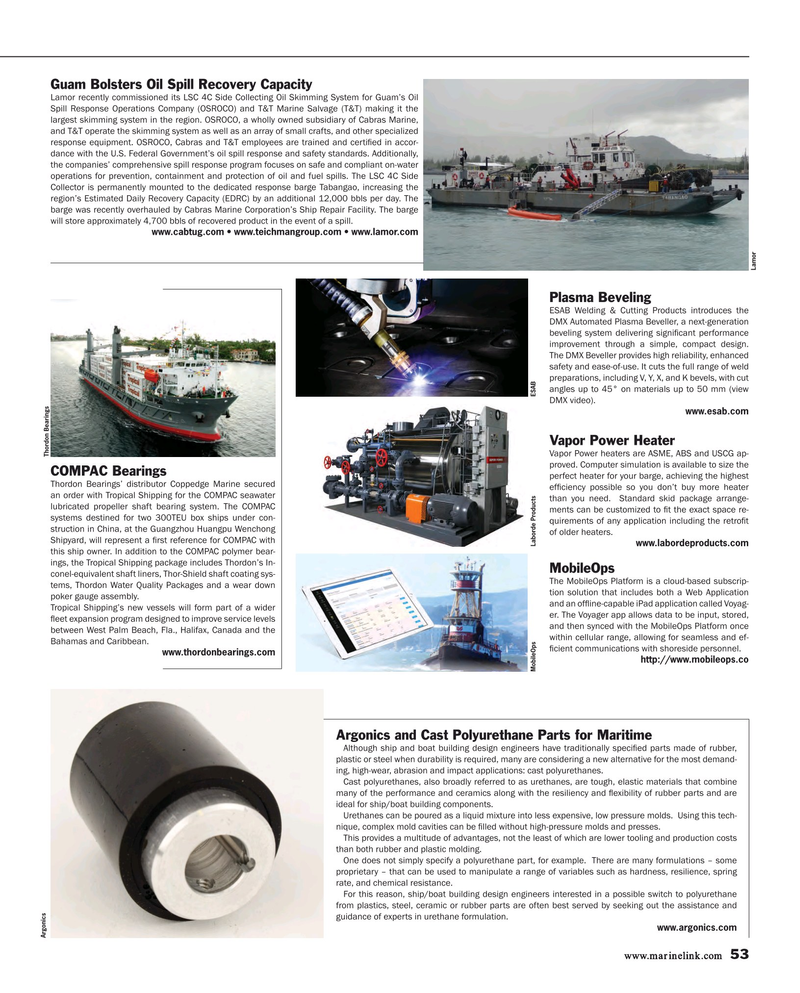
Page 53: of Maritime Reporter Magazine (September 2017)
U.S. Navy Quarterly
Read this page in Pdf, Flash or Html5 edition of September 2017 Maritime Reporter Magazine
Guam Bolsters Oil Spill Recovery Capacity
Lamor recently commissioned its LSC 4C Side Collecting Oil Skimming System for Guam’s Oil
Spill Response Operations Company (OSROCO) and T&T Marine Salvage (T&T) making it the largest skimming system in the region. OSROCO, a wholly owned subsidiary of Cabras Marine, and T&T operate the skimming system as well as an array of small crafts, and other specialized response equipment. OSROCO, Cabras and T&T employees are trained and certi? ed in accor- dance with the U.S. Federal Government’s oil spill response and safety standards. Additionally, the companies’ comprehensive spill response program focuses on safe and compliant on-water operations for prevention, containment and protection of oil and fuel spills. The LSC 4C Side
Collector is permanently mounted to the dedicated response barge Tabangao, increasing the region’s Estimated Daily Recovery Capacity (EDRC) by an additional 12,000 bbls per day. The barge was recently overhauled by Cabras Marine Corporation’s Ship Repair Facility. The barge will store approximately 4,700 bbls of recovered product in the event of a spill.
www.cabtug.com • www.teichmangroup.com • www.lamor.com
Lamor
Plasma Beveling
ESAB Welding & Cutting Products introduces the
DMX Automated Plasma Beveller, a next-generation beveling system delivering signi? cant performance improvement through a simple, compact design.
The DMX Beveller provides high reliability, enhanced safety and ease-of-use. It cuts the full range of weld preparations, including V, Y, X, and K bevels, with cut angles up to 45° on materials up to 50 mm (view
DMX video).
www.esab.com
Vapor Power Heater
Vapor Power heaters are ASME, ABS and USCG ap-
Thordon Bearings proved. Computer simulation is available to size the
COMPAC Bearings perfect heater for your barge, achieving the highest
Thordon Bearings’ distributor Coppedge Marine secured ef? ciency possible so you don’t buy more heater an order with Tropical Shipping for the COMPAC seawater than you need. Standard skid package arrange- lubricated propeller shaft bearing system. The COMPAC ments can be customized to ? t the exact space re- systems destined for two 300TEU box ships under con- quirements of any application including the retro? t struction in China, at the Guangzhou Huangpu Wenchong of older heaters.
Shipyard, will represent a ? rst reference for COMPAC with www.labordeproducts.com this ship owner. In addition to the COMPAC polymer bear- ings, the Tropical Shipping package includes Thordon’s In-
MobileOps conel-equivalent shaft liners, Thor-Shield shaft coating sys-
The MobileOps Platform is a cloud-based subscrip- tems, Thordon Water Quality Packages and a wear down tion solution that includes both a Web Application poker gauge assembly. and an of? ine-capable iPad application called Voyag-
Tropical Shipping’s new vessels will form part of a wider er. The Voyager app allows data to be input, stored, ? eet expansion program designed to improve service levels and then synced with the MobileOps Platform once between West Palm Beach, Fla., Halifax, Canada and the within cellular range, allowing for seamless and ef-
Bahamas and Caribbean. ? cient communications with shoreside personnel. www.thordonbearings.com http://www.mobileops.co
MobileOps Laborde Products ESAB
Argonics and Cast Polyurethane Parts for Maritime
Although ship and boat building design engineers have traditionally speci? ed parts made of rubber, plastic or steel when durability is required, many are considering a new alternative for the most demand- ing, high-wear, abrasion and impact applications: cast polyurethanes.
Cast polyurethanes, also broadly referred to as urethanes, are tough, elastic materials that combine many of the performance and ceramics along with the resiliency and ? exibility of rubber parts and are ideal for ship/boat building components.
Urethanes can be poured as a liquid mixture into less expensive, low pressure molds. Using this tech- nique, complex mold cavities can be ? lled without high-pressure molds and presses.
This provides a multitude of advantages, not the least of which are lower tooling and production costs than both rubber and plastic molding.
One does not simply specify a polyurethane part, for example. There are many formulations – some proprietary – that can be used to manipulate a range of variables such as hardness, resilience, spring rate, and chemical resistance.
For this reason, ship/boat building design engineers interested in a possible switch to polyurethane from plastics, steel, ceramic or rubber parts are often best served by seeking out the assistance and guidance of experts in urethane formulation. www.argonics.com
Argonics www.marinelink.com 53
MR #9 (50-57).indd 53 MR #9 (50-57).indd 53 9/6/2017 11:48:06 AM9/6/2017 11:48:06 AM

 52
52

 54
54
